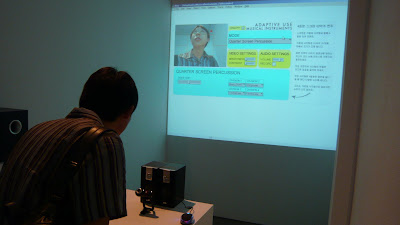
▪ 제 목: Universal Electronic Art
▪ 일 정: 2008. 10. 11 (토) ~ 11.16 (일)
▪ 장 소: 성남아트센터 http://www.snart.or.kr/
▪ 오 프 닝: 2008.10.11 (토) 10:30
▪ 참여작가: BLU(이탈리아), 후지키 준(Fujiki Jun, 일본), G.R.L(Graffitti Reseach Lab, 미국), 앤드류 히에로니미(Andrew Hieronymi, 미국), 로만 키르쉬너(Roman Kirschner, 독일), 폴린 올리베로스 외(Pauline Oliveros et al., 미국), 데이비드 A. 파커(David A. Parker, 미국), 지하루 & 그래험 웨이크필드(Haru Ji &Graham Wakefield, 한국/미국), 김기철, 김다희, 김별이, 김병규 외, 김윤철, 서효정, 이명주, 이재민, 전나현, 전병삼, 조경문, 최승준, 홍성대(이상 한국)
성남아트센터 에서는 시민들이 직접 작품에 참여하는 특별한 미디어아트 전시인 “유니버설 일렉트로닉 아트 Universal Electronic Art” 展을 준비했습니다. 유니버셜 디자인Universal Design*개념에서 착안한 유니버설 일렉트로닉 아트는 현대예술과 과학기술, 공학이 만나 새로운 인터페이스를 개발, 연출, 사용하는 미디어아트 작업입니다. 이번 전시는 관람객이 단순히 유희적이고 소극적인 의미에서의 참여를 넘어서, 다양한 체험을 통해 우리 일상생활과 가깝게 닿아 있는 미디어아트를 만나게 될 것입니다. 또한 다양한 인터페이스를 통해서 인간의 감각기관을 참신하고 새롭게 사용하여, 신체적인 장애가 있는 장애인들과 비장애인들이 함께 작품을 감상할 수 있는 미디어아트 플랫폼을 제시하는 등의 시도를 통해서 미디어아트라는 것이 현대미술의 특수한 장르로서 어렵고 재미없는 것이 아니라, 그 어느 장르보다 흥미롭고 우리의 일상과 닿아 있을 뿐 아니라, 더 나아가 모두가 더불어 함께 사는 미래를 위한 신나는 미래 청사진을 그려볼 수 있는 기회를 제공하고자 합니다.























.jpg)

















.jpg)
.jpg)
.gif)





